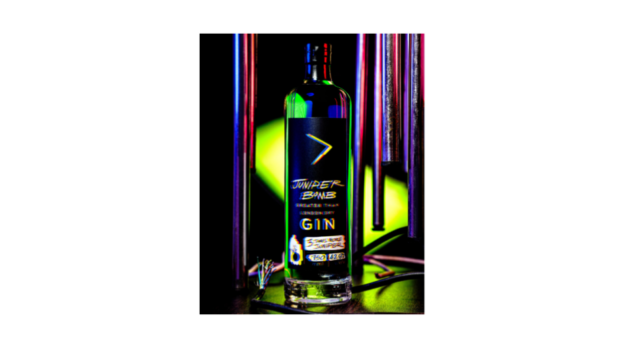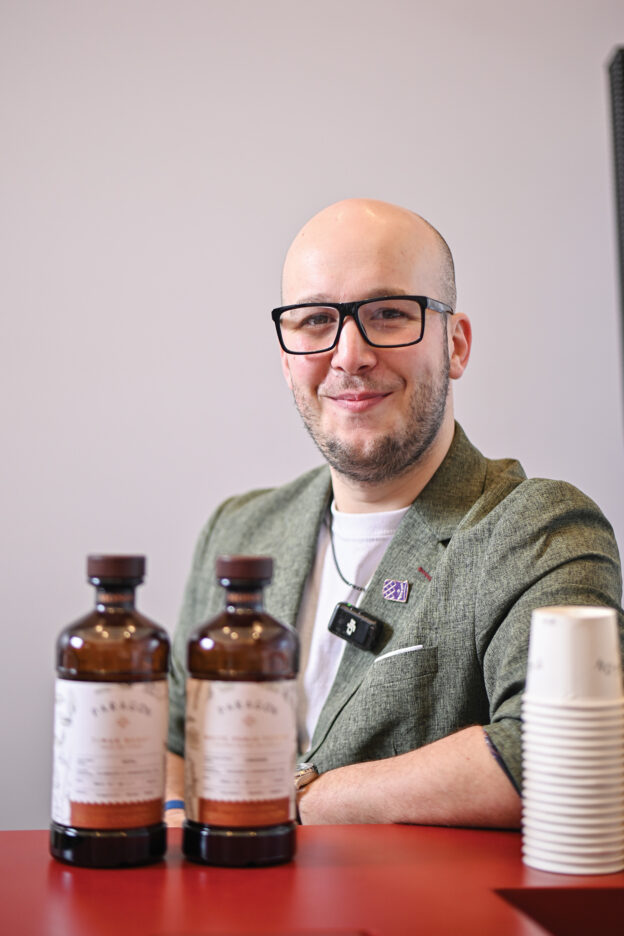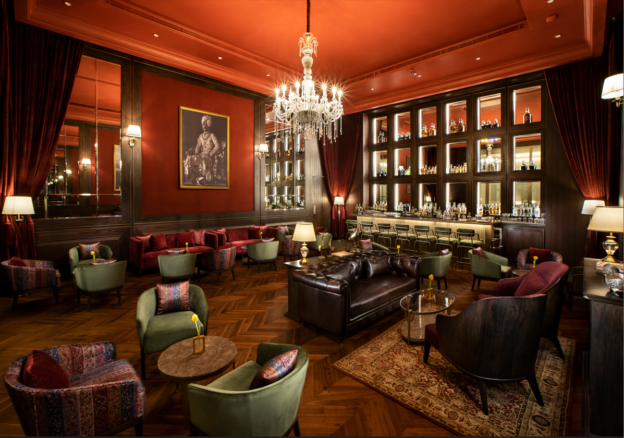From whisky distilleries to award-winning bars, Tony Kousoulou has spent over 15 years figuring out what makes a great drink work. Whether consulting on cocktail menus or experimenting with molecular mixology, he has always had a knack for blending flavour with technique. In 2021, he joined MONIN, swapping the late nights behind the bar for a role that lets him shape the future of drinks on a bigger scale. As Global Advocacy Beverage Expert for Paragon, he now works with bartenders around the world, helping them make the most of MONIN’s range; especially the botanical concentrates that are shaking up cocktail-making. Currently in India, Tony is working with some of the country’s best mixologists to explore new possibilities with Paragon. We sat down with him to chat about his journey, the changing bar scene, and why coriander keeps turning up in unexpected places.
You’ve had an incredible journey in the hospitality industry, from working with gin and whisky distilleries to consulting for award-winning bars. What led you to MONIN, and how has the transition been for you?
I had always used MONIN products throughout my career, so I was fairly familiar with the range MONIN offered, but the idea of working for a brand that shared similar values to mine—while making quality products and maintaining a fantastic CSR policy—was the biggest factor that appealed to me.
I had also worked my last bartending gig throughout the COVID-19 pandemic, and once restrictions started to lift, I decided to close that chapter of my career and focus on brand-related work. I’ve now been with MONIN for almost four years and haven’t looked back once.
Regarding my transition, I joined the company towards the end of the pandemic, when things were fairly quiet. This gave me plenty of time to familiarise myself with the whole range, which includes over 250 unique products.
MONIN is a globally recognised brand in the beverage industry. How do you see its role evolving in the world of cocktails and mixology today?
The staffing crisis in hospitality is not just a local issue but a global one. We’re seeing lower staff retention, fewer training opportunities provided by venues, and sadly, less passion behind the bar.
We’re aligning ourselves with a more advocacy-based approach, championing creativity while helping venues upskill and develop their staff. As an example, we’ve developed a training programme called MONIN-FUSION, which explores multiple ways to create in-house products behind the bar using a stable and consistent base (our MONIN products). This programme covers everything from foams, liqueurs, super-blends, garnishes, cordials, and much more.
With bartenders constantly experimenting with flavours, how are MONIN products being received in high-end bars across the UK, Europe, and India? Have you seen a shift in how mixologists use them?
In the past, many high-end venues dismissed commercially made syrups altogether. However, in recent years, through brand training and relationship-building, we’ve made significant progress.
One of the biggest challenges with high-end venues is their pursuit of innovative flavours while maintaining consistency. You could easily create the best possible version of a wild strawberry syrup, but can you replicate it exactly a week later? Will the sugar content be identical? Will the colour hold? Most importantly, will it taste the same?
With global supply issues and increased seasonality, our products offer reliability; whether you open a bottle in January or in the middle of August, the flavour remains the same.
Paragon, the latest addition to MONIN’s portfolio, is all about botanical concentrates. What inspired this range, and how do you see it changing cocktail-making?
Paragon is all about the pursuit of excellence while highlighting flavours and regions that are often underrepresented in the drinks and food industry. The idea was to bring these outstanding flavours—often found in remote areas—into the hands of bartenders.
We use a combination of acids and extraction methods to create a liquid that is perfectly balanced between sweet and sour, with an intense burst of flavour. This means bartenders can create drinks with the complexity of 8-10 ingredients while using only a few. All thanks to Paragon!
Among the ingredients in the Paragon range, white Penja pepper and Timur berry stand out for their unique profiles. What are some of the most exciting ways you’ve seen them used in cocktails?
There are quite a few to choose from! The most exciting ones I’ve seen play into the natural flavour profiles of the peppers themselves.
For example, Timur berry has bright notes of pink grapefruit in both aroma and taste, with a subtle numbing spice in the background. I’ve seen many variations of the Paloma using this as a substitute for both agave and pink grapefruit juice. Because of the nature of the liquid, you essentially get a completely clarified Paloma with no compromise on flavour; something that leaves guests wondering how it was achieved.
What’s the biggest challenge in introducing new flavours or products to bartenders and the alcohol industry? How do you overcome it?
I wouldn’t necessarily call it a “challenge”, as it’s part of my role at MONIN. However, we are known for pushing the envelope with innovation across all our ranges.
This sometimes means we introduce flavours or products that most people haven’t tried before. It’s on us to get out there, advocate for them, provide knowledge and training, and immerse our customers in the possibilities these flavours offer. It’s a lot of work, but it’s essential for bringing world-class products to bartenders.
You’ve worked with some of the finest names in the industry. Can you share a career highlight or an unforgettable product innovation that has stayed with you?
Not directly related to me, per se, but seeing many amazing people I’ve worked with over the years go on to open their own venues or take on key roles in global brands has been a personal highlight. Career growth is great, but it’s even better when you see your friends thrive.
With India being one of the fastest-growing markets for premium spirits and craft cocktails, what trends have caught your attention during your visit?
If I had to name just one, it would be the Picante. Back home in the UK, it’s growing in popularity year after year, but it’s often made in multiple ways, most without coriander, which is actually a key ingredient.
I’ve seen some really interesting takes on Picantes throughout my travels in India, all staying pretty faithful to the original concept. Bonus points for all the fabulous whisky highballs I’ve tried. It’s my go-to drink.
Are there any exciting expansions or new MONIN products in the pipeline that bartenders and mixologists should look forward to?
We have a new factory opening in early 2026. Once fully operational, it will allow us to introduce more region-specific flavours…think raw mango and spiced jamun. I can’t reveal too much yet, but exciting things are in the works!
What’s next for you at MONIN? Any special collaborations or projects in the works that will excite the beverage industry?
I’ve a few things I’m working on internally, mainly new product developments for the UK market, which may well launch globally if they prove to be successful. I’m always open to suggestions and ideas to present to our R&D department, so I encourage people to reach out.
Besides that, hopefully, some more travel later in the year. I’ve always wanted to visit our Yuzu plantation in Portugal. Maybe even make it to Athens Bar Show?
Rapid-Fire Round
1. If you had to create a cocktail inspired by your personality, what would it be called and why?
The Maverick. A lot of my colleagues poke fun at me for straying from classic expectations of what drinks should be.
2. One MONIN flavour you think is underrated but has massive potential?
Guava. It works well with almost any spirit and is by far my favourite of the tropical/exotic flavours we have.
3. If you could have a drink with any legendary bartender—past or present—who would it be, and what would you sip on?
Sasha Petraske, hands down. I’ve read ‘Regarding Cocktails’ cover to cover numerous times and had the pleasure of going to Milk & Honey in London a couple of times before it closed due to COVID-19. Easily some of the best approaches to cocktails and service I’ve ever seen.
4. What’s the strangest or most unexpected ingredient you’ve ever mixed into a cocktail?
Clarified pig’s blood. Please don’t ask me to elaborate. Those were dark times.
5. Describe your India visit in one drink. What would it be, and what ingredients would it feature?
Likely some form of a coriander-spiced whisky highball; a combination of the two drinks I’ve enjoyed the most here (Picante + Highball). Probably with a dash of Paragon Timur.




